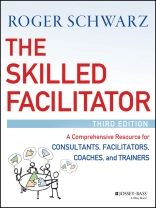Help groups deliver results with an updated approach to facilitation and consulting
The Skilled Facilitator: A Comprehensive Resource for Consultants, Facilitators, Trainers, and Coaches, Third Edition is a fundamental resource for consultants, facilitators, coaches, trainers, and anyone who helps groups realize their creative and problem-solving potential. This new edition includes updated content based on the latest research and revised models of group effectiveness and mutual learning. Roger M. Schwarz shows how to use the Skilled Facilitator approach to: boost improvement processes such as Six Sigma and Lean, create a psychologically safe learning environment for training, and help coaches work with teams and individuals in real-time. This edition features a new chapter that explains how to facilitate virtual teams using conferencing technology.
Facilitation skills are essential in many kinds of work, and if you are looking to bring your skills up to date it is critical that you rely on trusted information like the knowledge offered in this go-to reference.
- Develop the facilitative mentality and skills that enable you to help groups get better results, even in the most challenging situations
- Help groups achieve greater performances, stronger working relationships, and higher levels of individual well-being
- Quickly develop productive and trusting work relationships with the groups you help
- Establish the functions of your facilitative role
- Implement a research-based, systematic approach to diagnose and intervene in groups and improve their performance and results
The Skilled Facilitator is a practical resource for corporate, government, non-profit, and educational practitioners, as well as graduate students in group-focused programs. This edition contains up-to-date material, based on recent studies, to help facilitators move beyond arbitrary tactics to utilize cutting edge, research-based strategies that improve group processes, relationships, mindsets, and outcomes.
Tabella dei contenuti
Preface to the Third Edition xvii
What The Skilled Facilitator is About xvii
Who This Book is For xix
How the Book is Organized xix
Features of the Book xxii
What’s Different in the Third Edition xxiii
Part One The Foundation 1
1 The Skilled Facilitator Approach 3
The Need for Group Facilitation 3
Most People Who Need to Facilitate Aren’t Facilitators 3
Is This Book for You? 4
The Skilled Facilitator Approach 8
Experiencing the Skilled Facilitator Approach 10
Making the Skilled Facilitator Approach Your Own 11
Summary 12
2 The Facilitator and Other Facilitative Roles 13
Choosing a Facilitative Role 13
Basic and Developmental Types of Roles 23
Serving in Multiple Facilitative Roles 25
When It’s Appropriate to Leave the Role of Facilitator 25
The Group is Your Client 28
What is Your Responsibility for the Group’s Results? 29
Summary 33
3 How You Think is How You Facilitate: How Unilateral Control Undermines Your Ability to Help Groups 35
How You Think: Your Mindset as an Operating System 36
Two Mindsets: Unilateral Control and Mutual Learning 37
How You Think is Not How You Think You Think 37
The CIO Team Survey Feedback Case 38
The Unilateral Control Approach 41
Values of the Unilateral Control Mindset 41
Assumptions of the Unilateral Control Mindset 45
Unilateral Control Behaviors 46
Results of Unilateral Control 50
Give-Up-Control Approach 55
How Unilateral Control Reinforces Itself 55
How Did We Learn Unilateral Control? 56
Moving from Unilateral Control to Mutual Learning 57
Summary 58
4 Facilitating with the Mutual Learning Approach 59
The Mutual Learning Approach 59
Values of the Mutual Learning Mindset 61
Assumptions of the Mutual Learning Mindset 75
Mutual Learning Behaviors 77
Results of Mutual Learning 80
The Reinforcing Cycles of Mutual Learning 84
Are There Times When Unilateral Control is the Better Approach? 85
Summary 86
5 Eight Behaviors for Mutual Learning 87
Using the Eight Behaviors 87
Behavior 1: State Views and Ask Genuine Questions 89
Behavior 2: Share All Relevant Information 94
Behavior 3: Use Specific Examples and Agree on What Important Words Mean 97
Behavior 4: Explain Reasoning and Intent 99
Behavior 5: Focus on Interests, Not Positions 101
Behavior 6: Test Assumptions and Inferences 103
Behavior 7: Jointly Design Next Steps 114
Behavior 8: Discuss Undiscussable Issues 117
Learning to Use the Behaviors 119
Summary 120
6 Designing and Developing Effective Groups 121
How a Team Effectiveness Model Helps You and the Teams and Groups You Work With 122
The Difference between Teams and Groups—and Why It Matters 122
How Interdependence Affects Your Work with Teams and Groups 127
The Team Effectiveness Model 128
What’s Your Mindset as You Design? 132
Team Structure, Process, and Context 133
Team Structure 134
Team Process 139
Team Context 143
Interorganizational Teams and Groups 150
Helping Design or Redesign a Team or Group 150
Summary 153
Part Two Diagnosing and Intervening with Groups 155
7 Diagnosing and Intervening with Groups 157
What You Need to Diagnose 158
What You Need to Intervene 160
The Mutual Learning Cycle 160
Summary 163
8 How to Diagnose Groups 165
Step 1: Observe Behavior 165
Step 2: Make Meaning 171
Step 3: Choose Whether, Why, and How to Intervene 178
Challenges in Diagnosing Behavior and How to Manage Them 186
Summary 192
9 How to Intervene with Groups 193
Key Elements of the Intervention Steps 193
Using the Mutual Learning Cycle to Intervene: An Example 196
Step 4: Test Observations 198
Step 5: Test Meaning 200
Step 6: Jointly Design Next Steps 203
How to Move through the Intervention Steps 205
Choosing Your Words Carefully 209
Summary 212
10 Diagnosing and Intervening on the Mutual Learning Behaviors 213
How Mutual Learning Behaviors Differ from Many Ground Rules 213
Contracting to Intervene on Mutual Learning Behaviors 214
Intervening on the Mutual Learning Behaviors 218
Behavior 1: State Views and Ask Genuine Questions 220
Behavior 2: Share All Relevant Information 220
Behavior 3: Use Specific Examples and Agree on What Important Words Mean 221
Behavior 4: Explain Reasoning and Intent 222
Behavior 5: Focus on Interests, Not Positions 223
Behavior 6: Test Assumptions and Inferences 225
Behavior 7: Jointly Design Next Steps 227
Behavior 8: Discuss Undiscussable Issues 230
Summary 231
11 Using Mutual Learning to Improve Other Processes and Techniques 233
Using Mutual Learning to Diagnose and Intervene on Other Processes 233
Diagnosing and Intervening When Groups are Using a Process Ineffectively 235
Diagnosing and Intervening on Processes That are Incongruent with Mutual Learning 237
Diagnosing and Intervening on Processes That Espouse Mutual Learning: Lean and Other Continuous Improvement Approaches 244
Summary 246
12 Diagnosing and Intervening on Emotions—The Group’s and Yours 249
The Challenge 249
How People Generate Emotions 250
How Groups Express Emotions 252
Managing Your Own Emotions 254
Deciding How to Intervene 256
Intervening on Emotions 259
Helping People Express Emotions Effectively 259
Helping People Reduce Defensive Thinking 259
Helping the Group Express Positive Emotions 265
When People Get Angry with You 267
Learning from Your Experiences 267
Summary 268
Part Three Agreeing to Work Together 269
13 Contracting: Deciding Whether and How to Work with a Group 271
Why Contract? 272
Five Stages of Contracting 272
Stage 1: Making Initial Contact with a Primary Client Group Member 274
Stage 2: Planning the Facilitation 283
Stage 3: Reaching Agreement with the Entire Group 293
Stage 4: Conducting the Facilitation 295
Stage 5: Completing and Evaluating the Facilitation 295
Summary 297
14 Working with a Partner 299
Deciding Whether to Partner 299
Dividing and Coordinating the Labor 306
Allocating Roles within Your Division of Labor 308
Developing Healthy Boundaries between You and Your Partner 310
Debriefing with Your Partner 314
Summary 314
15 Serving in a Facilitative Role in Your Own Organization 317
Advantages and Disadvantages of the Internal Facilitative Role 317
How Your Internal Facilitative Role is Shaped 320
Shaping Your Facilitative Role 321
Changing Your Facilitative Role from the Outside In 329
Summary 330
Part Four Working with Technology 333
16 Using Virtual Meetings 335
Choosing Which Type of Virtual Meeting Technology to Use—If Any 336
The Challenges That Virtual Meetings Create 339
Designing and Facilitating Virtual Meetings to Meet These Challenges 341
Summary 345
Notes 347
Acknowledgments 361
About the Author 363
About Roger Schwarz & Associates’ Work with Clients 365
The Skilled Facilitator Intensive Workshop 367
Index 369
Circa l’autore
ROGER SCHWARZ is an organizational psychologist and president and CEO of Roger Schwarz & Associates, Inc., a consulting firm that helps teams create fundamental change to get better results. He facilitates leadership teams and teaches, consults, coaches, and speaks on facilitation, leadership, and developing effective teams. He is the author of Smart Leaders, Smarter Teams and The Skilled Facilitator Fieldbook, and blogs for Harvard Business Review. Contact him at www.schwarzassociates.com or find him on Twitter @Lead Smarter.












